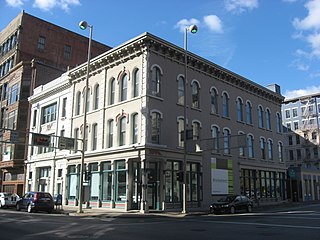
Latta is a town in Dillon County, South Carolina, United States. Latta is the second largest town in Dillon County. As of the 2010 census, it had a population of 1,379.

William Bowen Campbell was an American politician and soldier. He served as Governor of Tennessee from 1851 to 1853, and was the state's last Whig governor. He also served four terms in the United States House of Representatives, from 1837 to 1843, and from 1866 to 1867.

The James Weir House is a historic building formerly located in downtown Tazewell, Tennessee, United States.

John Rankin was an American Presbyterian minister, educator and abolitionist. Upon moving to Ripley, Ohio, in 1822, he became known as one of Ohio's first and most active "conductors" on the Underground Railroad. Prominent pre-Civil War abolitionists William Lloyd Garrison, Theodore Weld, Henry Ward Beecher, and Harriet Beecher Stowe were influenced by Rankin's writings and work in the anti-slavery movement.

The Tennessee State Capitol, located in Nashville, Tennessee, is the seat of government for the U.S. state of Tennessee, serving as home of the Tennessee General Assembly and the location of the governor's office. Designed by architect William Strickland (1788–1854) of Philadelphia and Nashville, it was built between 1845 and 1859 and is one of Nashville's most prominent examples of Greek Revival architecture. The building, one of 12 state capitols that does not have a dome, was added to the National Register of Historic Places in 1970 and named a National Historic Landmark in 1971.

William Alfred Buckingham was a Republican who served as the Governor of Connecticut during the Civil War and then as a United States Senator.

Daniel Smith Donelson was a Tennessee politician and soldier. The historic river-port of Fort Donelson was named for him as a Brigadier in the Tennessee militia, early in the American Civil War, in which he went on to serve as a Confederate general, notably at Perryville and Stones River. He was the nephew of America's seventh president, Andrew Jackson.
Samuel Cole Williams was a noted 19th and 20th century Tennessee jurist, historian, educator, and businessman.
This is a list of the National Register of Historic Places listings in Knox County, Tennessee.

H. W. Derby Building is a registered historic building in Cincinnati, Ohio. The building was designed by architect Samuel Hannaford. It listed in the National Register on March 3, 1980.

Cherry Mansion is a historic antebellum house in Savannah, Tennessee, located on a bluff overlooking the east bank of the Tennessee River. It has historical significance for its role as General Ulysses S. Grant's headquarters at the time of the Civil War Battle of Shiloh.

The Rev. M.L. Latta House was a historic home located in the Oberlin neighborhood of Raleigh, North Carolina. It was the last remaining building from Latta University, a trade school for African Americans that operated from 1892 until 1920. The house was named after Morgan London Latta, a freedman and former slave who graduated from Shaw University after the Civil War. It was built about 1905, and was a substantial, two-story Queen Anne style residence with a Tuscan order wraparound porch. He founded Latta University to educate freedmen and orphans in Raleigh's African-American community and built the campus next to his house. His house was listed on the National Register of Historic Places in 2002, and designated a Raleigh Historic Landmark.

The John Rankin House is a historic house museum at 6152 Rankin Hill Road in Ripley, Ohio. Built in 1828, it was home to Presbyterian abolitionist John Rankin, and was one of the original stops on the Underground Railroad. Harriet Beecher Stowe's visit to Rankin provided some of the story that became Uncle Tom's Cabin. The house was acquired by the State of Ohio in 1938 and is now operated by the Ohio History Connection and opened for tours. It was designated a National Historic Landmark in 1997.

Washington College Academy was a private Presbyterian-affiliated educational institution located in Washington College, Limestone, Tennessee. Founded in 1780 by Doctor of Divinity Samuel Doak, the Academy for many years offered accredited college, junior college and college preparatory instruction to day and boarding students, but financial difficulties in the 2000s forced the school to restructure its offerings and focus instead on continuing education courses for adults.
The Tennessee Historical Commission (THC) is the State Historic Preservation Office for the U.S. state of Tennessee. Headquartered in Nashville, it is an independent state agency, administratively attached to the Department of Environment and Conservation. Its mission is to protect, preserve, interpret, maintain, and administer historic places; to encourage the inclusive diverse study of Tennessee's history for the benefit of future generations; to mark important locations, persons, and events in Tennessee history; to assist in worthy publication projects; to review, comment on and identify projects that will potentially impact historic properties; to locate, identify, record, and nominate to the National Register of Historic Places all properties which meet National Register criteria, and to implement other programs of the National Historic Preservation Act of 1966 as amended. The Tennessee Historical Commission also refers to the entity consisting of 24 Governor-appointed members and five ex officio members.

The Jacob Critz House is a ca. 1835 center-hall house in Thompson's Station, Tennessee, United States. It was listed on the National Register of Historic Places in 1988. When listed the property included one contributing building, one non-contributing building, and one non-contributing structure, on 1.7 acres (0.69 ha). The property was covered in a 1988 study of Williamson County historical resources.
Peter J. Williamson was a Dutch-American architect.

The William H. Griffitts House is a historic farmhouse on Jackson Ferry Road in Loudon County, Tennessee, United States, northwest of Greenback and near the edge of Tellico Lake. It is listed on the National Register of Historic Places.
Rufus Reid (1797–1854) was an American plantation owner, businessman and politician from North Carolina.

The Henegar House is a historic house in Charleston, Tennessee. Constructed in 1849, it is the oldest remaining brick structure in Bradley County. It was listed on the National Register of Historic Places (NRHP) in 1976.














